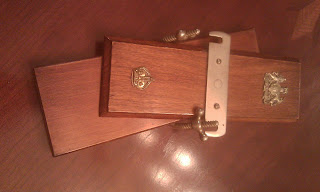I procured this odd little gem at the Polo Shop in New York City back in the mid-1990's and it has sat on a shelf or dresser in my home ever since. Every once in awhile someone will ask what the devil is that? And I'll enjoy regaling them with a quick history lesson about men's style and fashion. I don't know the heritage of mine, but I would hope that for the $250 I paid our good friend Ralph, this one has some history. I can only dream! It is adorned with a royal crest and crown, so I'm thinking it belonged to a Duke or Prince in the late 1800's and pressed only the finest of neckwear. I keep thinking that one day I'll go on the antiques road show and see if what I have is really something special.
Here's what our educational friends at Wikipedia tell us:
Tie presses usually operate based on two separate wooden boards which are clamped together with spring loaded levers. A cardboard cut-out is usually included to retain the shape of the tie during pressing.
Tie presses are particularly useful for bow ties, due to the creasing and thus deformative nature of the bow tie knot, which involves crushing the ends to produce the 'bow' effect. In time, this crushing affects the appearance of the finished knot. This is particularly the case with bow ties with rectangular ends, rather than the 'bow' shaped ends in some bow ties, though both suffer from crushing to some degree or another. Four-in-hand ties, naturally, are also creased, but rarely to the same extent and, as such, usually require less regular pressing.
As you can see from these examples, many were beautifully crafted with in-laid wood or painted with scenery. And some were very utilitarian, but they all did the same job.










I have an ACME tie press. I understand ACME was a well known name for manufacture of a multitude of items. Interested to learn more.
ReplyDelete